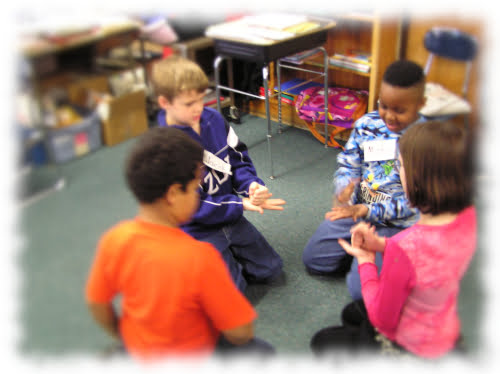As artists we know words can be very powerful. They move us to tears, bring us a smile or two, and paint vivid pictures in our minds. We labor over the right adverb, the right character name, the right phrase that completes a lyrical line, the right dialogue to enhance a mood, the right word to make an audience gasp. It is this same care that dominates our work when we set about writing assessments.
Assessment & Evaluation
Speaking of words, I want to begin by defining two important words, assessment and evaluation. Often assessment and evaluation are used interchangeably and in some venues this makes perfect sense. In the world of education, however, which is dominated by the need for accountability and rigor, assessment and evaluation have distinct connotations.
Assessment comes from the Latin “assidere” meaning to “sit by” or “sit beside.” Imagine a master teacher of long ago sitting beside a student learning to play an undocumented song being handed down from one generation to the next. The teacher would be right there listening and watching. When the student had accomplished the piece and was ready to move on to the next, the teacher would present a new song; but if the student was not ready, the teacher would correct, encourage, model, and instruct until the piece was learned. Sounds wonderful – the way teaching and learning should be. However, in a room of 30 students, how does a teacher sit beside each one and make a judgment about his or her learning and understanding? This is where the art of assessment comes in – to create a method where a teacher can sit beside each student in some way. In assessment today, evidence of individual learning is collected and recorded through performance tasks, presentations, papers, dialogue, journals, written work, portfolios, tests, etc.
The overall goal of assessment is to improve individual student learning and understanding over time in the content areas. When students have been assessed, a teacher is able to recount who has learned and understands and who does not. The teacher knows who has mastered the piece and who needs more instruction.
Evaluation, on the other hand, looks at the bigger broader picture. The root of this word is also Latin, meaning “value.” Here it is about making a value judgment. Evaluation is often reflected in an assigned grade based on subjective analysis. Evaluation reflects the overall quality and talent that a student displays. Teachers make quick evaluations of their class when they see how many students participate in discussion, the number of hands that get raised following a question, and by looking at the work of a few representative students.
Assessment can be used as part of evaluation, but an evaluation cannot be used for assessment. Think of assessment as the collection of ongoing information and evaluation as the overall picture of the value of a student’s work. For example, a classroom of students might participate in a concentration warm-up at the beginning of class and you evaluate that they can all concentrate; however, when students present their performance pieces for assessment, some of them show they cannot sustain concentration. They laugh, giggle, and talk to the audience. Through the assessment, you can now see the ability of each individual student to apply the skill of concentration in practice, and you can collect that information to present to the students as feedback.
Writing the Assessment
Now we turn our attention to how words assist us in collecting data on individual students, painting a picture of how well they are progressing, and providing a vehicle for feedback. Since we have so many students to sit beside, we often do this in writing (though verbal feedback can also be powerful). One of the best collection tools for giving detailed feedback is a rubric, which can be used for any type of student performance or product. The rubric has two parts: criteria and descriptors indicating different levels of accomplishment. When writing a rubric, the preciseness of our words becomes essential, especially if we want to use it for reliable assessment purposes and apply it in an objective and fair way.
Criteria
Let’s start with the criteria. This is the list of things you want to measure.
First, select criteria that are highly important to the subject area. Often I have seen teachers select criteria (concepts and skills) that are easy to assess but are not necessarily the most important areas of learning to assess. For example, in music, I saw a teacher labor over taking each child aside to see if they could identify a loud sound from a soft sound. This took two days of valuable class time. Would this have been better to be evaluated rather than assessed? Was it important to assess all students to see if they could identify loud and soft? Or is it more important to see if each student can identify or analyze the type of sounds that contribute to creating a mood? It is for each teacher to think deeply about the criteria being placed on a rubric and not necessarily go for what is easy. It is to consider what is most important.
Second, is this the criteria you are really assessing? I read a rubric the other day that had creativity listed as one of the criteria for an art project. Now, I will admit that creativity is something that should be taught with rigor through our art forms. It is essential content. But the descriptors for creativity clearly indicated the teacher was looking at neatness, use of materials, and craftsmanship -‐ not creativity. It made me wonder then if creativity as a skill or concept had even been taught.
Third, make sure you have explicitly taught that criteria before you assess it. Does more need to be said here?
Fourth, have the students suggest the criteria. If you are wondering if you have fairly selected criteria and adequately taught them, have the students list the things they think should be included in the assessment. This will provide you with a clear snapshot of what came through in your teaching.
Painting the Picture: Selecting the Right Adverb or Adjective
Now let’s turn out attention to the descriptors: those little boxes on a rubric that describe what exceeds, meets, does not meet, and absent looks like (or Academy Award Winner, Lead Actor, Understudy, Back to Acting School as I like to use). There are so many things to consider here--this gets to the heart of crafting assessments. A descriptor should be:
- - written in student language
- - written so a person outside of your art form could use it – no jargon
- - free of fuzzy words
- - focused and not overly compounded
- - written so frequency words make sense
Let’s take these factors one at a time:
It should be written in student language. A rubric is for the student. It sets out what the student should be doing, how they should be doing it, and what it looks like in best practice. It is there so the students can see a target, understand the target, aim as high as they can, and be able to fairly determine where they have landed until they get to try again. So it should be written in grade level appropriate language and given to the students throughout instruction.
It should be written so a person outside of the art form can use it. Assess your rubric with another adult sitting beside you. When he or she uses the rubric is the result the same? Check the rubric for jargon from the art form that only an insider would know. Now, if this is a word you use with the students daily and is part of their vocabulary, make an exception. You will diminish the universality of the rubric, but it will still be fair in your instance.
It should be free of fuzzy words. This is crucial. I see many words used in rubrics that make me wonder - words like clearly, appropriately, well, etc. If I read, “He sang the song appropriately” in a rubric, I would ask, “What does that mean, ‘appropriately’?” If the person answers, “It was loud enough for everyone to hear, there were no pitch problems, and the words were all memorized,” I would respond by saying, “Well, write that in your descriptor – that makes sense.” This is another reason to have someone sit beside us as we polish our rubrics, because even the best of us slip in these subjective words that have no substance. We don’t want to tell a child, “You didn’t sing appropriately,” and have him go away not being aware of what was incorrect and how to improve it. The whole notion behind assessment is to improve learning. To do this, we must be clear, concise, complete, and as minimalistic as possible.
It should be focused and not overly compounded. Let’s return to our music example which is now free of fuzzy words. Once we have determined what we mean by “appropriately” we now have a list of skills -‐ loudness, on pitch, memorized – within the descriptor. The next step is to determine if each of these should be their own criteria, with their own descriptor, or if they should continue to be grouped together. Think this through. What if the student is loud and on pitch, but misses a word or two? Does this move her down to the next level? Do all three of these items carry the same weight or value within the assessment? Splitting or lumping is a major decision.
It should be written so frequency words make sense. First, congratulations for considering a rubric when a frequency rating scale would be so much easier. By frequency words I mean: all, some, none, most, few, never, sometime, 3 times, 50%, etc. A frequency rating scale uses frequency words but no descriptors. Sometimes people like to combine the two. This should be done with care as sometimes it creates fuzziness. For instance, sticking with our music example, let’s say we write the following descriptors for memorization: remembered all of the words to the song; remembered some of the words to the song; remembered a few of the words to the song; remembered none of the words to the song. As a student, my questions would be, “What is the difference between some and few? Couldn’t some be a few? Could a few be some?”
Words are so important when crafting assessments. Don’t be afraid to elicit support and work as a team with others. The writing should be specific and clear to paint a picture for the student of what his work, project, or performance should look like EXPLICITLY. We want students to understand and to be able to demonstrate their understanding.
Remember… assessment needs the right words, choosing them is an art.
© 2017 Karen L. Erickson
We know words can be very powerful. Choosing the right words leads to clear and effective assessments. Selecting them is an art...but you don't need to do them yourself. We have many grade-appropriate assessments linked to national standards. Join today for a free trial!











